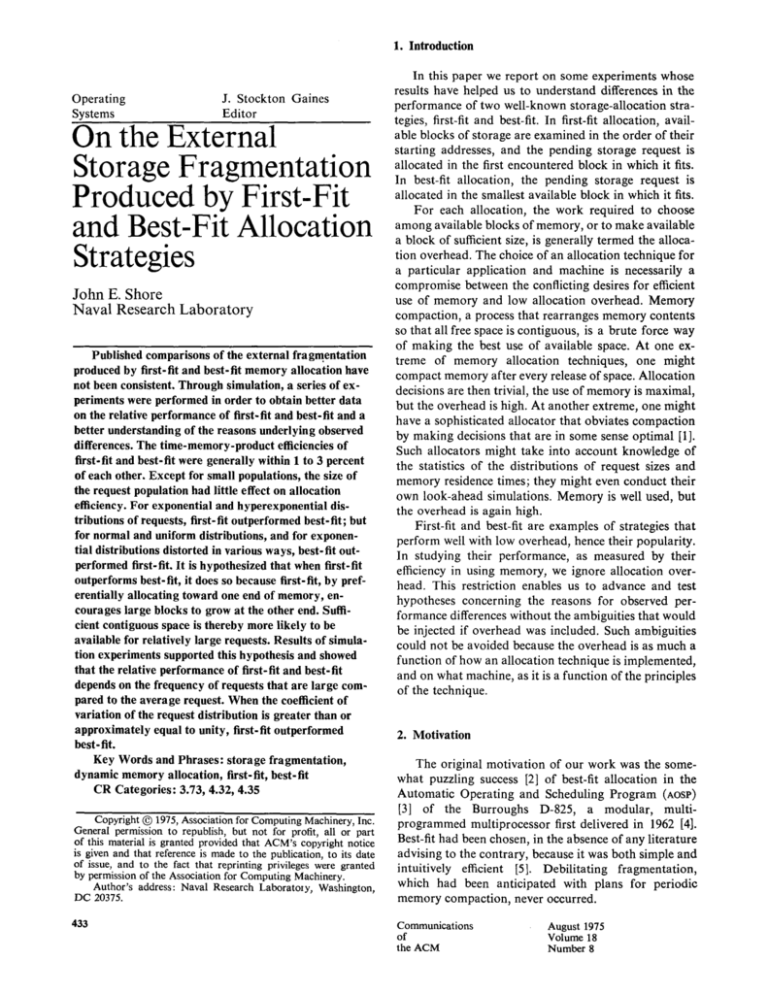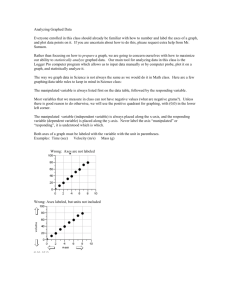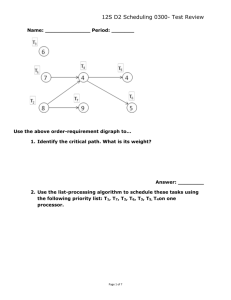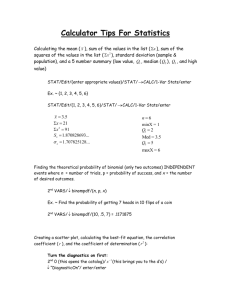On the external storage fragmentation produced by first
advertisement

1. Introduction
Operating
Systems
J. Stockton Gaines
Editor
On the External
Storage Fragmentation
Produced by First-Fit
and Best-Fit Allocation
Strategies
John E. Shore
Naval Research Laboratory
Published comparisons of the external fragmentation
produced by first-fit and best-fit memory allocation have
not been consistent. Through simulation, a series of experiments were performed in order to obtain better data
on the relative performance of first-fit and best-fit and a
better understanding of the reasons underlying observed
differences. The time-memory-product efficiencies of
first-fit and best-fit were generally within 1 to 3 percent
of each other. Except for small populations, the size of
the request population had little effect on allocation
efficiency. For exponential and hyperexponential distributions of requests, first- fit outperformed best- fit; but
for normal and uniform distributions, and for exponential distributions distorted in various ways, best-fit outperformed first-fit. It is hypothesized that when first-fit
outperforms best-fit, it does so because first-fit, by preferentially allocating toward one end of memory, encourages large blocks to grow at the other end. Sufficient contiguous space is thereby more likely to be
available for relatively large requests. Results of simulation experiments supported this hypothesis and showed
that the relative performance of first-fit and best-fit
depends on the frequency of requests that are large compared to the average request. When the coefficient of
variation of the request distribution is greater than or
approximately equal to unity, first-fit outperformed
best-fit.
Key Words and Phrases: storage fragmentation,
dynamic memory allocation, first- fit, best- fit
CR Categories: 3.73, 4.32, 4.35
Copyright © 1975, Association for Computing Machinery, Inc.
General permission to republish, but not for profit, all or part
of this material is granted provided that ACM's copyright notice
is given and that reference is made to the publication, to its date
of issue, and to the fact that reprinting privileges were granted
by permission of the Association for Computing Machinery.
Author's address: Naval Research Laboratory, Washington,
DC 20375.
433
In this paper we report on some experiments whose
results have helped us to understand differences in the
performance of two well-known storage-allocation strategies, first-fit and best-fit. In first-fit allocation, available blocks of storage are examined in the order of their
starting addresses, and the pending storage request is
allocated in the first encountered block in which it fits.
In best-fit allocation, the pending storage request is
allocated in the smallest available block in which it fits.
For each allocation, the work required to choose
among available blocks of memory, or to make available
a block of sufficient size, is generally termed the allocation overhead. The choice of an allocation technique for
a particular application and machine is necessarily a
compromise between the conflicting desires for efficient
use of memory and low allocation overhead. Memory
compaction, a process that rearranges memory contents
so that all free space is contiguous, is a brute force way
of making the best use of available space. At one extreme of memory allocation techniques, one might
compact memory after every release of space. Allocation
decisions are then trivial, the use of memory is maximal,
but the overhead is high. At another extreme, one might
have a sophisticated allocator that obviates compaction
by making decisions that are in some sense optimal [1].
Such allocators might take into account knowledge of
the statistics of the distributions of request sizes and
memory residence times; they might even conduct their
own look-ahead simulations. Memory is well used, but
the overhead is again high.
First-fit and best-fit are examples of strategies that
perform well with low overhead, hence their popularity.
In studying their performance, as measured by their
efficiency in using memory, we ignore allocation overhead. This restriction enables us to advance and test
hypotheses concerning the reasons for observed performance differences without the ambiguities that would
be injected if overhead was included. Such ambiguities
could not be avoided because the overhead is as much a
function of how an allocation technique is implemented,
and on what machine, as it is a function of the principles
of the technique.
2. Motivation
The original motivation of our work was the somewhat puzzling success [2] of best-fit allocation in the
Automatic Operating and Scheduling Program (AOSP)
[3] of the Burroughs D-825, a modular, multiprogrammed multiprocessor first delivered in 1962 [4].
Best-fit had been chosen, in the absence of any literature
advising to the contrary, because it was both simple and
intuitively efficient [5]. Debilitating fragmentation,
which had been anticipated with plans for periodic
memory compaction, never occurred.
Communications
of
the ACM
August 1975
Volume 18
Number 8
Literature published since the AOSP design choices
were made has been inconclusive, both about the relative performance of first-fit and best-fit, as well as about
the reasons underlying such differences. Collins [6] reported that best-fit performs slightly better than first-fit,
although he gave no details. In a stimulating discussion,
Knuth [7] reported on a series of simulations that
showed first-fit to be superior, and he offered an explanation for these results*. He did not, however, give
many details about the actual performance.
Against this background, we decided to study best-fit
and first-fit allocation. Because best-fit and first-fit
seem to embody distinctly different systematic effects
and because we wanted to restrict the number of variables, we chose not to include in our study such intermediate strategies as modified first-fit [7].
3. Simulation Description
We simulated the allocation of an infinite proffered
workload of storage requests in a fixed-size memory.
Storage is allocated in units of one word so that no more
than the requested amount is ever allocated. Resulting
fragmentation is therefore purely external [8]. The event
driven simulator maint~fins a list of available-storage
blocks. When an allocated block is released, the simulator determines whether it is located adjacent to one or
two blocks already on the available-storage list. If so,
the appropriate blocks are combined by modifying the
available-storage list. If not, the newly released block is
added to the list. The simulator then attempts to allocate
the pending storage request. If there is space for it, the
request is allocated at the low address end of whichever
available block is selected by a prespecified allocation
strategy. The available-storage list is then modified, and
the newly allocated space is scheduled for release at a
time computed from a prespeeified distribution or
algorithm. Following a successful allocation, the simulator continues to generate and allocate new requests until
an attempted allocation fails. Whenever failure occurs,
the simulator advances to the next scheduled storage
release and continues as described in the foregoing until
a prespecified time limit is reached. Summary statistics
are then stored, and the simulator begins anew after
reinitializing everything but the random number generator. During one run, the simulation is repeated for a
prespecified number N of such iterations, after which the
statistics for each iteration and the averages over the
ensemble of iterations are printed.
In all of the simulations reported herein, the
memory-residence time of requests was continuously
and uniformly distributed between 5.0 and 15.0 time
units. Memory contents were therefore replenished on
the average once every 10 time units. Preliminary studies
showed that major transients in the various performance statistics subsided by about 5 to 10 memory replenishments, so that in production runs no statistics
434
were gathered until at least 50 time units had elapsed.
Iteration time limits for production runs were typically
500 to 3000 units.
In referring to distributions of storage requests we
shall use the following notation:
------mean of request generating distribution.
------standard deviation of request generating distribution.
M -- memory size (M = 32K for all results reported
herein).
X --1/~.
a -- coefficient of variation (~/~).
Exponential, hyperexponential, normal, and uniform
distributions are available for generating requests. Requests outside of the interval [0,M] are discarded, and
all requests are truncated to the nearest whole word.
These actions will not produce significant distortions of
the generating distribution p(x) provided that the
following conditions hold:
1 << ? << M,
(IA)
o'p(x) dx ~ 1.
(1B)
If the exponential distribution p(x) = X exp(Xx), for example, is used, the probability density function of requests that satisfy 0 _< x _< M and are truncated to the
nearest integer k is
1 - exp (--X)
p(k) = 1 -- exp (--XM) exp (--Xk),
(2)
where k = 0, 1 , . . . M -- 1. The condition (1A) implies XM >> 1 and X << 1 so that eq. (2) becomes
p(k) ~ X exp(--Xk).
Two options are available concerning the size of the
population of possible requests. When what we call the
full population is used, storage requests are obtained
directly from the appropriate generating distribution
each time a new request is needed. When what we call a
partial population is used, P requests are obtained from
the appropriate generating distribution during the initialization phase of each iteration of a simulation run.
These P requests are retained for the duration of the
iteration, and storage requests are generated by choosing randomly from among them. It is important to note
that the full population is not equivalent to a partial
population with P = M, since, unless the generating
distribution is uniform, it is most unlikely that all of the
M different requests that can be generated by the full
population will be included in the partial population.
The assumption of an infinite proffered workload is
an aspect of the simulation that merits further discussion. As an alternative, we could have assumed a finite
workload in which requests are scheduled in accordance
with some distribution of arrival times. To see that this
would have introduced an unnecessary degree of
freedom, suppose that two different allocation strategies
are successful in accommodating a given finite workload
Communications
of
the ACM
August 1975
Volume 18
Number 8
in a given sized memory, where by successful we mean
that no allocation attempt ever fails. The most significant measurements are then those that quantify the
degree of storage fragmentation. Such measurements
are of interest only insofar as they may predict which
of the two strategies would accommodate the largest
workload, or which would successfully accommodate
the given workload in the smallest memory. One might
study these questions empirically by increasing the
workload or decreasing the memory size until one of the
strategies saturates, that is, until one of them results in a
constant or growing queue of storage requests--a condition equivalent to an infinite proffered workload.
Clearly, one could gain the same information simply
by fixing the memory size, subjecting both strategies to
an infinite workload, and measuring the efficiencies.
3.1 Performance Measurement
Although the simulator gathers a wide variety of
statistics, all of our results will be presented in terms of
one figure of merit, the time-memory-product efficiency
E. If n requests r l , i = 1, 2 , . . . , n, are allocated for
times ti in a memory of size M during a total elapsed
time T, then the efficiency is defined as
E = ~
r~ h .
(3)
i=l
E is a direct measure of how well the memory has been
used and seems to us to be the best single figure of merit
with which to compare the performance of different
allocation strategies.
One alternative performance measure is the storage
utilization fraction U, defined as an average of a quantity Ut, which in turn is a function of the memory contents at any time t. If {r~t} is the set of requests that
happen to be resident in memory at time t, then
1
U, =---~ ~ r , .
The measures E and U are not generally equivalent.
Among other things, the difference depends upon how
samples Ut are selected for inclusion in the average U.
If the memory is sampled periodically, with an intersample time that is small with respect to the average
residence time of requests, then E and U are equivalent.
If samples Ut are taken only at times of allocation activity, then E and U will differ to the extent that residence times are a function of request sizes. To be more
specific, consider an extreme case in which we have a
partial population of only two requests, rl and r2.
Furthermore, let these requests satisfy the constraint
rl + r2 > M; i.e. only one request at a time fits in
memory. If r~ and r2 have fixed residence times of h and
h , respectively, then the allocation efficiency is given,
on the average, by E = (rxtl + r2h)/M(h + h), whereas
the storage utilization is, on the average, U = (r~ + r2)/
2M. If rx << r~ and r~ ~ M, then U ~ ½. But if it also
happens to be true that h << t2, then the performance
435
figure U ~ ½ is most misleading (consider the spacetime diagram). On the other hand, the efficiency E
approaches unity, as is appropriate for a measure of
how well memory has been used. The insensitivity of U
to memory residence times makes it a poor performance
measure.
As mentioned previously, in all of the simulations
reported herein, the memory residence times were uniformly distributed and independent of request size. In
the foregoing example, U and E become equivalent if
the memory residence times are independent of the
request sizes. That such an equivalence holds for the
general allocation problem as well can be seen from the
following argument: Given sufficient samples, one can
write the storage utilization in terms of average values
as U = ¢~/M. Here, ~ is defined as the average number
of requests that are resident in memory when a sample
Ut is taken. If the residence-time distribution is independent of the request-size distribution, then the
efficiency is, on the average,
E = Ntf/MT,
(4)
where N is the (ensemble) average number of requests
allocated during some long period of length T and t is
the average memory residence time. But N t / T is the
average number of requests resident at any time, hence
E and U are equivalent. The simulation results were
spot-checked to verify eq. (4) and the equivalence,
given request-size independent residence times, of E
and U. Both comparisons checked to two decimal
places.
Another alternative performance measure is
throughput, which might be defined as the average
number of requests allocated per unit time or as the
average amount of memory allocated per unit time.
But, given long time averages and stationary request
statistics, the throughput will be proportional, in both
cases, to E.
In general, results will be plotted as functions of
various parameters of the original request generating
distribution, rather than of the distorted distribution
that may result from restricting requests to integers on
the interval [0,M].
Owing to the stochastic nature of the simulation,
the allocation efficiency varies slightly from iteration to
iteration, even though the conditions being simulated
are the same for all iterations of a run. This point is
not important if one is comparing situations for which
the variance of the apparently normal distributions of
efficiencies are small compared to the distances between
their expected values. In most of our simulations,
however, the distribution of efficiencies obtained with
first-fit allocation overlapped that obtained with best-fit
allocation when all conditions, other than the allocation
strategy, were the same. It was, therefore, important to
sample the distributions sufficiently often to estimate
their expected values with enough accuracy to resolve
them. The expected values are estimated by averaging
Communications
of
the ACM
August 1975
Volume 18
Number 8
Fig. 3. Fraction of allocations in which requests could have fit in
more than one available block versus mean request ?. Data was
measured during the best-fit runs plotted in Figure 2.
1.0o
In the figures the memory size was 32K.
First-fit points are plotted as A.
Best-fit points are plotted as e , and in Fig. 1 are offset slightly to
of the first-fit points.
Worst-fit points are plotted as I .
is plotted as )<.
For allocation efficiencies, the error bars show the 95 percent confidence limits of the estimates of mean efficiency.
0.75
o~ 0.50
E
0.25
I
128
I
256
I
5t2
I
1024
I
2048
I
4096
I
8192
I
16584
r ~
Fig. 1. Allocation efficiency E of first-fit and best-fit versus size P
of the request population. The generating distribution was exponential with F = 1024. For P = 4, 100 iterations were averaged.
All other points are the result of averaging ten iterations.
Fig. 4. Allocation efficiency E of best-then-first-fit versus the
breakpoint B between the best-fit and first-fit regions. The request
distribution was exponential with ~ = 256. Each point is the result
of averaging 70 iterations.
I.OC
0.835
a9o
]tttt
Q830
t
t
0.80
t
1
I
w 0.825
0.820
0.70
I,
2
II
4
h
8
t
16
b
32
p~
II
64
h
128
h
256
~ /,~_~b
52
I
I
I
I
I
I
I
I
0
4K
8K
12K
16K
20K
24K
28K
B~
Fig. 2. Allocation efficiency E of first-fit, best-fit, and worst-fit
versus mean request ~ for exponentially distributed requests. Each
point is the result of averaging ten iterations.
Fig. 5. Allocation efficiency E of first-fit and best-fit, and measured
value of the coefficient of variation a, versus maximum request
r . . . . Requests were generated from an exponential distribution
with ~ = 1024 and ignored unless they satisfied 0 < r < r . . . .
Each point is the result of averaging 25 iterations.
a85
0.90
1.00
0.80
O75
0.85
1
"' 0.75
t
O50
t
w
0.80
BEST-FITJ - 02.5
0.70
I
128
436
I
32K
I
256
I
512
I
I
1024 2048
?" ~.
I
4096
I
8192
I
16384
0.75
I
I
I
I
I
I
512
1024
2048
4096
8192
16384
r max
Communications
of
the ACM
August 1975
Volume 18
Number g
C
Fig. 6. Allocation efficiency E of first-fit and best-fit, and measured
value of the coefficient of variation a, versus minimum request
rmin. Requests were generated from an exponential distribution
with ~ = 256 and ignored unless they satisfied rmin < r < 32K.
Each point is the result of averaging 25 iterations.
0.86 -~
tOO
..._
0.85-
.80
/
0.75
t0.84
o. ot
w
0.82 - I
t
I
16
8
~
E
S
T
-
F
I
T
~
.75
,70
T
o83 t
.85
/f
' ~ ,
FIRST-FIT
Fig. 9. Allocation efficiency E of first-fit and best-fit versus the
coefficient of variation a of the request distribution. The request
distribution was hyperexponential with mean request ~ = 512.
Each point is the result of averaging 10 iterations.
025
I
32
rmin
I
64
I
128
.65
I 0
256
Fig. 7. Allocation efficiency E of first-fit and best-fit, and measured
value of the coefficient of variation ,~, versus mean ~ of the request
distribution. Request distribution was uniform with a = 256. Each
point is th result of averaging 25 iterations.
1.oo
°9°
I
BEST-FIT.
m
0.85
t
LU
I
1.0
I
1.5
I
2.0
I
2.5
I
3.0
the efficiencies f r o m all iterations run under the same
conditions. In plotting these estimates we also show
their 95 percent confidence limits, which are given by
-4- 1.96 @(N) ~, where ~ is the standard deviation,
which we estimate f r o m the set o f samples and N is
the n u m b e r of iterations averaged. In general, the
observed distributions of efficiencies appeared to be
symmetrical a b o u t a single peak. In discussions that
follow, we assume that the mean efficiency coincides
with the peak o f the distribution.
0.8C
- 0.25
x
0.75
I
I
512
I
1024
[
2048
4096
~l,...
f
8192
o
Fig. 8. Allocation efficiency E of first-fit and best-fit, and measured
value of the coefficient of variation a, versus standard deviation ~r
of request distribution. Request distribution was uniform with
= 1024. Each point is the result of averaging 25 iterations.
-
tO0
0.87
0.75
3.2 Some
Hesitations
It is i m p o r t a n t to emphasize that the results o f
simulations like ours must be interpreted with caution.
F o r example, m u c h o f our w o r k is based on exponential distributions o f request sizes, and although some
published data shows exponential-like distributions,
[9] other data does not [I0]. Moreover, such simplifying
assumptions as well-behaved distributions,
independence o f successive requests, and independence o f
request size and duration are questionable [11]. The
assumption of a sequential set of requests in which no
new request is made until the previous one is satisfied
is realistic for certain situations only.
4. R e s u l t s
for Partial
Populations
0.86
0.50~u
0.85
uJ
0.84
0.25
0.83
I
128
437
I
256
I
O"---e,-
512
I o
1024
Initially, we investigated the relationship between
the size of the request population and the p e r f o r m a n c e
o f best-fit and first-fit. O u r motivation was W a l d ' s
hypothesis that the absence o f debilitating fragmentation in the AOSP'S use of best-fit was due to the discrete
population o f storage requests that a c c o m p a n i e d the
real time application [2]. Figure 1 shows the results o f
a series o f experiments in which a partial P-request
population was generated at the start of each iteration
Communications
of
the ACM
August 1975
Volume 18
Number 8
of the simulation by an exponential distribution with a
mean of 1024. As one should expect, the allocation
efficiency increased as P was reduced, but most of the
increase was confined to the region P < 16. For the
full-population case, first-fit outperformed best-fit by
about 1 percent. As P was reduced, the variance of the
measured efficiency increased to the point where we
could no longer resolve the relative performance, although the results suggest midly that, for small P,
best-fit outperformed first-fit. For P = 4, we tried to
resolve the relative performance by running 100 iterations, compared to 10 for all other points, but were
unsuccessful.
Because there were several hundred possible requests in the real time application of the D-825 [12],
Figure 1 implies that the success of best-fit reported by
Wald [2] was due more probably to a nonsaturating
workload, relative to the available storage and the
allocation efficiency of best-fit, than it was to the
discreteness of the request population.
5. Results for Full Populations
5.1 Initial Comparison of Best-Fit and First-Fit
In order to understand better the relative performance of best-fit and first-fit, we measured their
allocation efficiencies as a function of the mean of a
full, exponentially distributed population (see Figure 2).
In both cases the efficiency increased as the mean request decreased. When the mean request was less than
about 4K, first-fit consistently performed about 1 percent better than best-fit. When the mean request was
greater than 8K, the two strategies performed equally
well. These results of ours are consistent with those of
Knuth [7].
5.2 Knuth's Hypothesis and Worst-Fit
In trying to understand the reasons underlying the
observed performance differences, we began with a
hypothesis implied by Knuth [7]. This hypothesis
notes that, statistically speaking, the storage fragment
left after a best-fit allocation is smaller than that left
after a first-fit allocation. Because the smaller fragment
seems less likely to be useful in a subsequent allocation,
it follows that best-fit, by proliferating smaller blocks
than does first-fit, should result in more fragmentation
and lower efficiency than first-fit.
Because the foregoing hypothesis is difficult to test
directly, we considered a worst-case generalization.
That is, if the hypothesis is correct, it might be that
the best performance would result from a strategy that
systematically leaves the largest possible fragment.
Thus, allocation in the largest available block, or
worst-fit, should result in better performance than
either best-fit or first-fit. But it does not (see Figure 2).
Indeed, worst-fit is worse than both best-fit and firstfit. Furthermore, the superiority of best-fit over worst438
fit shows that, under some circumstances, it is better to
allocate a request in the available block that results in
the smallest remaining fragment.
Several aspects of Figure 2 merit further comment.
At first glance it might suggest that, in general, allocation efficiency depends most strongly on the ratio of the
mean request to the memory size. But such a conclusion
is unfounded. Since the mean and the standard deviation of exponential distributions are equal, Figure 2
equally supports the hypothesis that allocation efficiency
depends most strongly on the ratio of the standard
deviation of the request distribution to the memory size.
It is reasonable to expect that at least first and second
order statistics of the request distribution are important. For example, if M/? is a large integer, and if
we vary a while measuring E, then we expect E to
approach 1 as a becomes small with respect to F. If,
for a << ~, we vary 1= and measure E, then we expect
E to be a nonmonotonic function of e that has a local
maximum whenever M/? is integral, and is less than 1
between these points.
The near-equal performance of all three strategies
for ? ~> 8K is an intriguing result which we finally
traced to the simple principle that, whenever the average
request is a significant fraction of the memory size,
there is rarely more than one available block in which
a pending storage request can fit (see Figure 3). This
being the case, allocation efficiency cannot be affected
by allocation strategy.
The apparent decrease in the performance of worstfit as F is reduced from ~ ~ 1024 is in marked contrast
to the increase in the performance of both best-fit and
first-fit. As the limit e ---+ 1 is approached, the efficiency
of any reasonable strategy should approach I. Some
single-iteration runs indicated that the performance of
worst-fit begins increasing again at about ~ = 32. The
shallow peak in the performance of worst-fit between
f ~ 4096 and ~ ~ 128 and the tiny mean request
required before a performance increase is again observed are results for which analytic explanations
should be extremely illuminating.
5.3 A Mixed Strategy To Test a Hypothesis for the
Superiority of First-Fit
It is reasonable to attribute the superior performance
of best-fit over worst-fit to the beneficial effect of allocating a request in the available block that results in the
smallest remaining fragment. Since first-fit outperforms
best-fit, and since first-fit does not choose the available
block that results in the least remainder, it must embody
a beneficial effect that competes with the beneficial
effect of best-fit and, for the circumstances we have
considered so far, dominates it. It seems reasonable
that the key to such a beneficial effect should lie in the
one systematic effect produced by first-fit: preferential
allocation toward one end of memory. With this in
mind, we examined detailed outputs of the simulation
and noted that, as one might expect, the biggest de-
Communications
of
the ACM
August 1975
Volume 18
Number 8
creases in efficiency occurred when the m e m o r y could
not accommodate a relatively large request, with no
allocation taking place until a sufficient amount of
contiguous space accumulated. This observation led to
the hypothesis that, by preferentially allocating toward
one end of memory, first-fit encourages large blocks to
grow at the other end. Sufficient contiguous space is
thereby more likely to be available for relatively large
requests. Stated differently, allocation toward one end
of m e m o r y is a beneficial effect of first-fit that competes
with the small-remainder beneficial effect of best-fit.
To test this hypothesis, we devised a mixed allocation strategy that can be varied parametrically between
first-fit and best-fit in such a way to expose directly the
competition between beneficial effects. M e m o r y is
divided by a pointer B into two regions. The lower
region, words 0 through B, is termed the best-fit region.
The upper region, words B -t- 1 through M, is termed
the first-fit region. The allocator first tries to allocate
requests in the lower region using first-fit. If unsuccessful, it then tries to allocate requests in the upper region
using first-fit. Thus, when B = 0, pure first-fit results
and, when B = M, pure best-fit results. If the efficiency
of this best-then-first-fit strategy is measured as B is
varied from 0 to M, the efficiency should start at that
of pure first-fit and, as B approaches M, eventually drop
to that of pure best-fit. For small B, requests will still
be allocated preferentially toward the low end of
memory, but there will be some best-fit allocation
mixed in at the low end. Our hypothesis suggests that
under these circumstances we might enjoy some of the
beneficial effects of both first-fit and best-fit, in which
case, as B increases, the allocation efficiency would
increase before it drops to the value for pure best-fit.
The results of such an experiment supported our
hypothesis and are shown in Figure 4.
The foregoing best-then-first-fit experiment illustrated the danger of not paying sufficient attention to
estimation theory in such simulations. For B = 0, the
distribution of efficiencies coincides with the first-fit
distribution. As B varies from 0 to M, the distribution
changes shape and moves until, at B = M, it coincides
with the best-fit distribution. The experiment consisted
of estimating, as a function of B, the position of the
distribution's peak. The results (Figure 4) show that
the peak moves in the direction of higher efficiency
before moving down to coincide with the peak of the
distribution for pure best-fit. We had initially reached
a negative conclusion until we realized that the standard
error ( a / ( N ) ~) resulted in insufficient resolution to
detect the motion that was taking place for the number
of iterations that were considered originally.
5.4 Conditions Under Which Best-Fit Should Outperform
First-Fit
If, as was suggested, first-fit was more efficient than
best-fit because first-fit encourages the growth of
relatively large free blocks which are thereby available
439
more often for the allocation of relatively large requests, then the absence of such large requests should
eliminate the beneficial effect of first-fit. One way to
test this prediction is to generate requests f r o m an
exponential distribution that has been truncated at
r ..... < M. When rm~x = M, we have the same situation
as before--typical results were shown in Figure 2. As
r .... is reduced from M, fewer large requests are made,
the hypothesized beneficial effect of first-fit is depreciated, and best-fit should outperform first-fit. Results,
shown in Figure 5, confirm the prediction.
These results imply that the statistical advantage of
first-fit over best-fit depends on the frequency of requests that are large with respect to the mean request.
In order to make a more precise statement, we introduce
the coefficient of variation a given by the ratio of the
request-distribution's standard deviation to its mean,
a = ~/i=. The smaller a is, the smaller is the frequency
of requests that are large compared to r. F o r an exponential distribution truncated at rma~, we have a ~ 1
as long as 1 << ~ << r ...... When r ..... and f are of the
same order of magnitude, a < 1. In Fig. 5 we have also
plotted the measured value of a as a function of r . . . .
F r o m a statistical point of view it is more appropriate to think of the crossover in Figure 5 in terms of
the parameter a than in terms of the truncation point
r . . . . . Thus, if a is reduced by distorting the exponential
distribution in some other way than by decreasing the
truncation point, then a similar crossover should occur.
For example, in Figure 6 we show the results of an
experiment in which the lower end of an exponential
distribution was cut off at r,,,in. The results clearly
show a crossover in which best-fit becomes better than
first-fit as a drops below about .8.
In comparing these results with those shown in
Figure 2, it is important to note that, in Figure 6, the
absolute performance of both strategies increases with
rm~n, even though the actual mean request also increases with rmln, a result that underlines our previous
caution in interpreting Figure 2. Indeed, on the basis
of all of the results presented so far, one might now be
tempted to conclude that allocation efficiency is most
strongly dependent on ~, and only weakly dependent
on ~. But such a conclusion would be premature without
data from experiments with distributions for which
and a can be specified independently.
The present results may also explain the mild
implication, in Figure 1, that best-fit outperforms
first-fit for small request populations. Let s ~ be the
variance of n samples taken from a distribution whose
variance is ~2. Then the expectation value of s 2 is given
[13] by (s 2) = ~r2(n - 1)/n. Since the square root is a
concave function, we have the following estimate for
the expectation value of s itself [14]:
(s) = ((s~) ~) < ((s~)) ~.
Thus, since ~ = a for exponential distributions, the
expectation value of the coefficient of variation may be
Communications
of
the ACM
August 1975
Volume 18
Number 8
estimated, as a function of n, by (a) = "(s)/r < ((n 1)/n) ½. Thus, a is significantly less than 1 for small n.
5.5 Results for Uniform and Normal Distributions
In Figure 7 we show the results of an experiment in
which we varied the mean of a uniform distribution with
a constant standard deviation and measured the efficiency of first-fit and best-fit. In Figure 8 we show the
results obtained when the mean is held constant while
the standard deviation is varied. In both experiments
the efficiency of first-fit allocation never exceeded that
of best-fit. The ratio a was always quite small, we note
that, if w is the width of a uniform distribution, then
a = w / ( f (12)'~), and is maximal when p = w/2. Thus,
a .... = 2/(12) ~ = .577.
Similar experiments were performed using normal
distributions. The results were qualitatively the same
as those shown for uniform distributions [15]. A m o n g
other things, the combined results show that the absolute performance of an allocation strategy can depend
strongly on both the first moment and the second central
moments of the request distribution. The results also
lend further support for the hypothesis of Section 5.3
concerning the relative performance of best-fit and
first-fit.
5.6 Results for Hyperexponential Distributions
Results presented in previous sections suggest that
the superior performance of first-fit, seen when the
request distribution was exponential, should be accentuated for request distributions with a > 1. Such a
distribution is the hyperexponential distribution
p ( x ) = s e x p ( - - 2 s ~ x ) -1- (1 -- s)exp(--2(1 -- s)~x)
(0<s<½)
which has the coefficient of variation
a = [(1 -- 2s -k- 2s2)/2s(1 -- s)] ~.
When s = ½, the hyperexponential distribution becomes
exponential. In Figure 9, we show the results of an
experiment with hyperexponentials in which we increased a from ot = 1 while holding constant the
mean request. As a increased, so did the advantage of
first-fit over best-fit.
6. Summary
Through simulation, we have investigated the
performance of first-fit and best-fit allocation using,
as a figure of merit, the time-memory-product efficiency.
Under the conditions we observed, the efficiencies of
first-fit and best-fit were generally within 1 to 3 percent
of each other. Except for small populations, the size
of the request population had little effect on allocation
efficiency, although this result was inferred from experiments with exponential distributions only.
The absolute performance of first-fit and best-fit can
depend strongly on at least the first moment and the
44O
second-central moment of the request distribution.
There is strong evidence that the relative performance
of the two strategies depends on the frequency of requests that are large compared to the average request.
When this frequency is high, first-fit outperforms bestfit because, by preferentially allocating toward one end
of memory, first-fit encourages large blocks to grow at
the other end. In terms of the coefficient of variation
a = ~r/~, first-fit outperformed best-fit when a was close
to or greater than 1.
Acknowledgments. The author thanks H. Elovitz,
J. Kullback, and B. Wald for numerous helpful discussions. He is particularly grateful to J. Kullback for
illuminating various points in statistics and estimation
theory. He also thanks P. Denning and D. Parnas for
their constructive reviews of the manuscript. The
experiment with hyperexponentials was performed at
the suggestion of P. Denning, S. Fuller, and one of the
referees.
N o t e added in proof. Recently, Fenton and Payne
[16] have reported on some similar simulations. They
also concluded that best-fit performs better than firstfit for various nonexponential distributions.
Received January 1974, revised December 1974
References
1. Campbell, J.A. A note on an optimal-fit method for dynamic
allocation of storage. The Computer J. 14, 1 (Jan. 1971), 7-9.
2. Wa!d,B. Utilization of a multiprocessor in command
control. Proc. IEEE54, 12 (Dec. 1966), 1885-88.
3. Thompson,R., and Wilkinson, J. The D825 automatic
operating and scheduling program. Proc. AFIPS 1963 SJCC, pp
139-146, May 1963; reprinted in S. Rosen, Programming Systems
and Language, McGraw-Hill, New York, 1967.
4. Anderson,J.P., et al. D825--A multiple-computer system
for command and control. Proc. AFIPS 1962 FJCC, pp 86-96,
Dec 1962; reprinted in C.G. Bell and A. Newell, Computer
Structures-Readings and Examples, McGraw-Hill, New York,
1971.
5. Wald, B. Private communication.
6. Collins, G.O. Experience in automatic storage allocation.
Comm. ACM 4, 10 (Oct. 1961), 436-440.
7. Knuth, D.E. The Art of Computer Programming, Vol I
Fundamental Algorithms, Addison-Wesley,Reading, Mass.,
1968, pp. 435-452.
8. Randell, B. A note on storage fragmentation and program
segmentation. Comm. ACM 12, 7 (July 1969), 365-372.
9. Batson, A., Ju, S., and Wood, D.C. Measurements of segment
size. Comm. ACM 13, 3 (Mar. 1970), 155-159.
10. Totschek, R.A. An empirical investigation into the behavior
of the SDC timesharing system. Rep. SP2191, AD 622003,
System Development Corp., Santa Monica, Calif., 1965.
11. Margolin, B.H., Parmelee, R.P,, and Schatzoff, M. Analysis
of free-storage algorithms. IBM SYST J. 4, (1971).
12. Wilson, S. Private communication.
13. Fisz, M. Probability Theory and Mathematical Statistics.
Wiley, New York, 1963, Chap. 13.
14. Loeve, M. Probability Theory. Van Nostrand, New York,
1955, p. 159.
15. Shore, J.E. On the external storage fragmentation produced
by first-fit and best-fit allocation strategies. Naval Research
Lab. Memo. Rep. 2848, Washington, D.C., July 1974.
16. Fenton, J. S. and Payne, D. W. Dynamic storage allocation of
arbitrary sized segments. Proc. IFIP 74, North-Holland Pub. Co.,
Amsterdam, 1974, pp. 344-348.
Communications
of
the ACM
August 1975
Volume 18
Number 8









